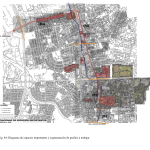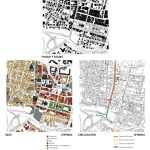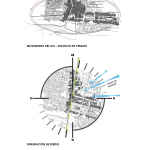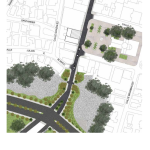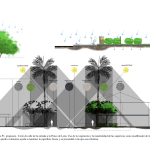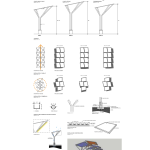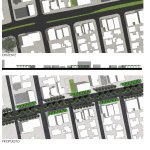Urbanismo & Clima: Adaptando los espacios urbanos en Puerto Rico a su clima tropical
“If we construct our house to feel comfortable living in it and the city is like a grand house, then our cities should be capable of providing a sense of comfort for those who inhabit it”. – José Martínez Rodríguez
“Si construimos nuestra casa para sentirnos cómodos y la ciudad es como una gran casa, entonces nuestras ciudades deben ser capaz de proveer un sentido de confort para aquellos que la habitan”. – José Martínez Rodríguez
Designer: José R. Martínez Rodríguez
Thesis Director: Emilio Martínez
Counselors: María M. Campos, Manuel Bermúdez
Jury Date: June 13, 2018
Location: Universidad de Puerto Rico Escuela de Arquitectura
TOS[er]: Julián A. Potes Riquelme
Publication Date: 11/…/2020
Designer José R. Martínez Rodríguez dedicates his research to understanding the conditions and the ongoing changes of the tropical humid climate of Puerto Ric. He then uses the data available to design urban pedestrian comfort that will help reduce local temperatures, enhance the pedestrian experience, promote social interaction as well as healthier lifestyles, discover cultural identity, prevent flooding, and to better respond to the tropical climate to obtain a more stable economy at all levels.
José mentions the challenges, based on climate data of the Tropic of Cancer, that architecture and urban design are facing. He points out the severity of the problem considering that the Tropic of Cancer makes up about 40% of the Earth’s crust. Puerto Rico is at the heart of this region and shares the same data collection issues; thus, he wants to use the scarce data available to understand the intersection of climate and urbanism on the island. He researches two precedents; the first is titled, “Effects of Urban Configuration on Human Thermal Conditions in a Typical Tropical African Coastal City” conducted in 2013 by Andreas Matzaraki and Emmanuel Ndetto, in which they evaluate a typical urban street and a frequented park in relation to their orientation, the neighboring buildings and diversity in flora that both cases are in the city of Dar es Salam; the second “Human Thermal Comfort Conditions and Urban Planning in Hot-Humid-Climates- The Case of Cuba” by José Abel Rodriguez Algegras, Helen Coch, Guillermo de la Paz Pérez, Mabel Chaos Yeras and Andreas Matzarakis in 2015 in which they evaluate the microclimates and the benefits for the thermal conditions appropriate for humans in cities such as Habana, Camagüey and Santiago de Cuba. Both investigations resulted in different solutions and strategies that guide José alternative solutions to shared tropical climate issues.
He then informs us of the rapid demographic change that occurred in the 20th century in urban cities such as San Juan and how this growth along with the limited data available, led to a city that never caught up with the rapidly changing demographics resulting in poorly-planned cities. The problems identified for Puerto Rico are elevated temperatures, high precipitation levels, and now, possibly stronger and more frequent hurricanes. Examples of this later phenomena were witnessed with hurricanes Irma (Category 4) and Maria (Category 5) in 2017 that were probably caused by the momentum climate change continues to gain. Based on data created by the architect Dario González in 1971 in the School of Architecture of the University of Puerto Rico and by NOAA in 2010, there has been a registered increase of 1.2ºF in the average annual temperatures as well as an increase of precipitation levels on the island of 0.37” compared to the data of 1971. The concern deepens as José presents data collected in 2016 that shows the annual average temperatures were more than 90.5ºF, that is 10ºF more than the annual average temperatures predicted and 14.08” of precipitation documented over the expectation.
At this point José explains to the importance of adapting urban spaces in Puerto Rico swiftly to these drastic changes that have been registered in the past 45 years. After an exhaustive analysis of the urban areas identified for his interventions, he proposes effective and diverse solutions in his master plan for the avenues Ponce de Leon and Roosevelt, in the heart of the Capital city of San Juan. Some enhance the orientation of streets in urban areas to create natural ventilationn taking advantage of Caribbean trade winds and the various approaches to protect the pedestrian successfully from the rain and the ultraviolet rays in the tropics. Among the elements introduced as solutions for these avenues, trees are the most critical component for the new urban approach because of their superior ability to create oxygen, lower local temperatures by several degrees with the shade they provide, enhance ventilation, prevent flooding, further push urban identity, and save businesses from high energy consumption. The rest of the catalogue of urban elements he proposes include the use of balconies, cantilevers, eaves, arches, arcades and the use of endemic tropical flora.
José’s master plan focuses on designing tropical cities that respond more efficiently to their climates, and challenges, and as he explains, “If we construct our house to feel comfortable living in it and the city is like a grand house, then our cities should be capable of providing a sense of comfort for those who inhabit it.”
TOS[er] Impression: José’s thesis is one of great significance and his research is an eye-opener. His work can serve as a, starting point for any project of tropical precedent. His assessments and genuine concerns reveal the importance of data collection and precedents for graduate work and how architects must learn to see the public space of the city as part of their range of influence. Trees produce oxygen and are essential to human survival, there is a challenge we face of debunking a bias against the use and maintenance impact of a tree in the city with regards to its roots and branches. It is essential for future designers to understand that a city with trees is a better city. José’s thesis incites a paradigm shift in the mind of the reader and offers a clearer vision of the goals and motivations that should lie at the heart of the pursuit of ecologically-aware designers as they conceptualize their ideas projects.



